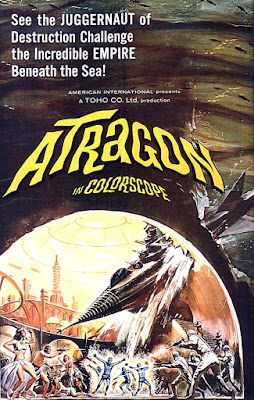(1963) Directed by Ishirô Honda; Written by: Shinichi Sekizawa; Based on novels by: Shigeru Komatsuzaki and Shunro Oshikawa; Starring: Tadao Takashima, Yôko Fujiyama, Yû Fujiki; Available format: DVD
Rating: ***
Director Ishirô Honda is probably best known for his numerous Shōwa era Godzilla movies, along with several other Japanese sci-fi/horror films of the 50s and 60s (notably, Rodan, Matango: Attack of the Mushroom People, and War of the Gargantuas). Atragon, however, is one title in Honda’s voluminous resume that often gets overlooked. The focus in this film is not on monsters (although there is one), but on men.
Perhaps one of the reasons that Atragon isn’t as widely known as some of Honda’s other contributions is that it’s rather tepid in the action department. Not much occurs in the first hour, unless you consider scene after scene of arguing and saber rattling to be riveting drama. What ultimately sets Atragon apart from many of its contemporaries, and ultimately makes it watchable is its socio-political commentary. No, really! Buried within the tiresome character conflicts is a clash between old and new Japan.
Trouble is brewing underneath the surface of the Pacific Ocean. An ancient civilization called the Mu Empire, presumably lost for thousands of years, suddenly makes its presence known. When the Mu continent sunk into the sea, it vanished from the memories and prying eyes of terrestrial dwellers. Now, the technologically advanced Mu Empire has decided to re-emerge, and assert its dominance over the nations of the surface. Apparently, their conquest involves scenes of the lost continent’s residents dancing around with togas and brightly colored wigs, but we’ll just let this slide. The Mu Empire wages war on the land, demanding the immediate halt to construction of the top-secret super-submarine Atragon.
So, how does the Mu Empire know about a weapon that most of the Japanese government isn’t aware of? In the waning days of World War II, Captain Jinguji went into self-imposed exile with a handpicked group of loyalists. During the next 18 years, they devoted their lives to secretly constructing the massive flying submarine Atragon, which would help return Japan to its former glory days. Jinguji was instrumental in developing the last few advanced submarine prototypes of the war, one of which fell into the hands of the Mu Empire. Unfortunately, that model also included the blueprints to the Atragon, a submarine capable of flight, armed with a freeze ray cannon and a drill mechanism for burrowing.
Once the whereabouts of the renegade Japanese captain and his men are discovered, it’s up to Jinguji’s daughter Makoto and former Admiral Kosumi to convince him that the world has changed, and the Atragon is needed for a new role. Jinguji, however, has never conceded defeat, and views the Atragon as a symbol of national pride, not peace keeping. This is probably the most intriguing aspect of Atragon, as it reveals some of the prevailing ambivalence of postwar Japan. This sentiment is embodied by the staunch traditionalist view of Jinguji, Kosumi’s (now the CEO of a shipping company) adaptation to a changed world, and a Japan no longer in touch with its past, as in Makoto. This conflict of perspectives was undoubtedly influenced by the country’s climate in the early 60s, when it was on the cusp of becoming a technological and economic powerhouse.
Alright, that’s just peachy, but what about the flying submarine? Where’s the worldwide devastation promised by the Mu Empire, and the cataclysmic explosions? Most of the action is fairly underwhelming. The Atragon doesn’t actually launch until roughly an hour into the film – a fairly substantial time to wait in a movie that’s barely longer than 90 minutes. I distinctly got the feeling that they spent all the money on the Mu sets, so there wasn’t much left to show the interiors of the Atragon. We get a few short glimpses, but not much more. Despite its giant size, we only see a dozen or so crewmembers. Just before things get a little too dull, we get some kaiju action, thanks to the sea serpent Manda, in a scene reminiscent of 20,000 Leagues Under the Sea .
(SPOILERS AHOY! Consider skipping to the last paragraph if you want to avoid learning too many details about the thrilling ending.)
By the time Atragon really gets going, it fizzles to an anti-climactic conclusion. This whole invasion of the land thing wasn’t too well thought out. Throughout the film, we’re led to believe that the all-powerful, super-advanced Mu Empire is unstoppable. It’s sort of a letdown when they’re defeated so easily. After smashing through a not-so-heavily fortified wall, Atragon’s crew easily overpowers the spear-wielding Mu guards with freeze ray guns. The entire Mu navy appears to consist of one sub with a laser cannon, unless you want to count Manda as part of their arsenal. I’m no military tactician, but I think the Mu Empire didn’t exactly consider their advantage. If they had the plans for Atragon, it would seem logical that they could find a way to identify and exploit a weakness (Death Star, anyone?). Of course, they could have just built their own improved version, or a fleet of Atragons for that matter. Maybe when I get to run my own empire, I’ll think of these things.
Disappointments aside, it’s easy to see how Atragon could have been the first in a series of flicks, featuring the further adventures of the flying submarine and its crew. It would have been interesting to see where things went, now that the origin story was out of the way, but this was not to be. Atragon wasn’t exactly Toho Studios or Honda’s finest moment, but it’s still worth a look if you’re an Ishirô Honda completist, or you’re looking for some unexpected commentary about postwar Japanese society.









Classic science fiction fantasy action adventure melodrama film released in 1963 based from the novel by Shunro Oshikawa inspiration of Captain Nemo & Jules Verne stories.
ReplyDelete